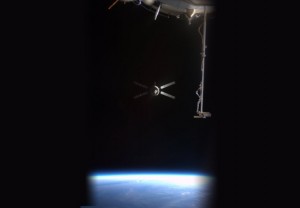It won’t be long now!
ESA’s Automated Transfer Vehicle (ATV) Edoardo Amaldi is set to undock from the International Space Station just after midnight tomorrow, at 00:35 CEST on 26 September 2012. The mission controllers at ATV-CC will then take over, steering Edoardo Amaldi through 28 hours of free flight, which will end with a controlled destructive reentry during the night of 26/27 September.
In no particular order, here are a series of notes and comments on the final activities in space and on ground to get ATV-3 ready to depart.
- The past days have seen the International Space Station crew performing a series of ‘close-out’ activities that include loading final waste and trash for disposal, taking photos and videos to record final views inside the vessel and closing the ATV-3 hatch. Last week, Russian cosmonaut Yuri Malenchenko performed the final transfers of urine from the ISS to ATV’s Tanks 1 and 3 (final liquid waste transfer to Tank #1 took place 21 Sep). Japanese astronaut Akihiko Hoshide transferred, loaded and re-arranged trash cargo inside ATV.
- The crew have been taking photos and videos during the past few days and sending the raw images down to earth. The ‘situational’ imagery of waste cargo stowage is being examined on ground for last-minute adjustments to ensure proper containment of all items and good centre-of-gravity positioning for stable manoeuvring during independent flight after undocking. ESA engineers can also do a pretty good C-of-G calculation just by knowing which waste and trash has been stored in which cargo rack.
ESA’s Kirsten MacDonell, ATV Phase E Cargo Integration Engineer, told me that in the X-axis (ATV’s flight direction), the tolerance for fixing the centre of gravity is just a few centimetres!
- ATV hatch closing is set for 18:55 CEST today. As usual, prior to hatch closure, the crew remove safety equipment (fire extinguisher and breathing apparatus), the inter-module air hose (the big white hose you always see in all the photos of the ATV hatch from inside station), and various hand grips and restraints from inside the ATV. They turn on a valve that stabilises ATV pressure after hatch closure, and turn off the ATV fan and smoke detectors. Then, 16 quick-release clamps are removed from around the periphery of the inter-hatch area between the ATV and the ISS. These equally spaced clamps further strengthened the connection between the ATV and the ISS during the docked phase. The crew now take a cap off an ATV depressurisation valve, carry out a final inspection of the interhatch area and close the ISS hatch. A pressure sensor is hereafter installed on the ISS hatch, the area between the hatches is depressurised (controlled by the ATV Control Centre), and a leak check is performed by the ISS crew.
- Today, @Aki_Hoshide will install the Reentry Breakup Recorder (REBR) in ATV-3. To get full details of this fabulous device, see our earlier posts.
In short, the REBR rides down with ATV (and HTV) to provide a cost-effective system to record data during the reentry and breakup of the vehicle. It returns the data for analysis via data link, and can even send data after splashing down in the Pacific (assuming it survives). Understanding how vehicles behave during atmospheric reentry gives future spacecraft developers unique information that can enhance design efficiencies and safety. This data can also be used to improve models of how bodies enter the atmosphere, which applies to NEO studies, among other areas.
The last REBR experiment reentered with JAXA’s HTV-3 on 14 September and relayed 11 minutes of data to ground before splashing into the S. Pacific. Additional details via NASA.
- Undocking: Set for 00:35 CEST on Wednesday, 26 Sep. We’ll update the ATV blog to bring you live posts as it happens.
- Free flight: Undocking will mark the start a 28-hour countdown to reentry, during which the vessel will be controlled around the clock by the joint ESA/CNES mission team at ATV Control Centre, Toulouse, France. Reentry will start after the second deorbit burn, around 04:30 CEST on 27 September with impact in an unpopulated area of the South Pacific expected around 05:30 CEST.
As always, dates/times are forecast only and may change as the mission develops. Follow us right here in the ATV blog for the latest news!


 Automated Transfer Vehicle page
Automated Transfer Vehicle page ATV blog archive
ATV blog archive
Discussion: 2 comments
I read that “Malenchenko performed the final transfers of urine from the ISS to ATV’s Tanks 1 and 3”. Isn’t urine recycled in the space station ?
Hi Koen:
“Water is lost by the Space Station in several ways: the water recycling systems produce a small amount of unusable brine; the oxygen-generating system consumes water; air that’s lost in the air locks takes humidity with it; and the CO2 removal systems leach some water out of the air, to name a few.”
Via https://science.nasa.gov/science-news/science-at-nasa/2000/ast02nov_1/